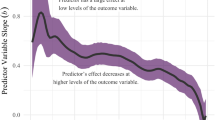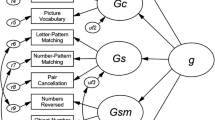Abstract
The Kaufman Test of Educational Achievement, 3rd edition (KTEA-3) is a popular battery for the assessment of students’ academic skills. Its manual includes a series of confirmatory factor analyses to support construct validity. Its five-factor model did not include all available subtests in the battery and required covarying residuals between certain subtests, which could suggest that it measures additional abilities beyond its specified factors. Further, its factors appear highly correlated which suggests the presence of a general factor. This investigation supplements the analyses in the manual with both an oblique rotation and a higher-order exploratory factor analysis using a Schmid-Leiman rotation within multiple grade ranges. Results suggest that the KTEA-3 is factorally complex. The Schmid-Leiman rotation indicates that it is a measure of both a general ability, and perhaps an additional naming facility factor.
Similar content being viewed by others
References
Abbott, R. B., Berninger, V. W., & Fayol, M. (2010). Longitudinal relationships of levels of language in writing and between writing and reading in grades 1 to 7. Journal of Educational Psychology, 102, 281–298. https://doi.org/10.1037/a0019318.
Berliner, D. C. (2009). Are teachers responsible for low achievement by poor students? Kappa Delta Pi Record, 46(1), 18–21.
Berninger, V. W. (1999). Coordinating transcription and text generation in working memory during composing: automatic and constructive processes. Learning Disability Quarterly, 22, 99–112.
Berninger, V. W., Proctor, A., De Bruyn, I., & Smith, R. (1988). Relationship between levels of oral and written language in beginning readers. Journal of School Psychology, 26, 341–357. https://doi.org/10.1016/0022-4405(88)90042-8.
Berninger, V. W., Abbott, R. D., Jones, J., Wolf, B. J., Gould, L., Anderson-Youngstrom, M., Shimada, S., & Apel, K. (2006). Early development of language by hand: composing, reading, listening and speaking connections; three letter-writing modes; and fast mapping in spelling. Developmental Neuropsychology, 29, 61–92.
Breaux, K. C., & Lichtenberger, E. O. (2016). Essentials of KTEA-3 and WIAT-III assessment. Hoboken: John Wiley & Sons, Inc..
Breux, K. C., Bray, M. A., Root, M. M., & Kaufman, A. S. (2017). Introduction to the special issue and to KTEA-3 error analysis. Journal of Psychoeducational Assessment, 35, 4–6. https://doi.org/10.1177/0734282916669656.
Canivez, G. L., & McGill, R. J. (2016). Factor structure of the differential ability scales-second edition: exploratory and hierarchical factor analyses with the core subtests. Psychological Assessment, 28, 1475–1488. https://doi.org/10.1037/pas0000279.
Canivez, G. L., Watkins, M. W., & Dombrowski, S. C. (2016). Factor structure of the Wechsler intelligence scale for children—fifth edition: exploratory factor analyses with the 16 primary and secondary subtests. Psychological Assessment, 28, 975–986. https://doi.org/10.1037/pas0000238.
Chen, H., & Zhu, J. (2012). Measurement invariance of WISC-IV across normative and clinical samples. Personality and Individual Differences, 52, 161–166. https://doi.org/10.1016/paid.2011.10.006.
Devena, S. E., Gay, C. E., & Watkins, M. W. (2013). Confirmatory factor analysis of the WISC-IV in a hospital referral sample. Journal of Psychoeducational Assessment, 31, 591–599. https://doi.org/10.1177/0734282913483981.
Dombrowski, S. C. (2015). Exploratory bifactor analysis of the WJ-III achievement at school age via the Schmid-Leiman orthogonalization procedure. Canadian Journal of School Psychology, 30, 34–50. https://doi.org/10.1177/0829573514560529.
Dombrowski, S. C., & Watkins, M. W. (2013). Exploratory and higher order factor analysis of the WJ-III full test battery: a school age analysis. Psychological Assessment, 25, 442–455. https://doi.org/10.1037/a0031335.
Dombrowski, S. C., Canivez, G. L., Watkins, M. W., & Beaujean, A. A. (2015). Exploratory bifactor analysis of the Wechsler intelligence scale for children-fifth edition with the 16 primary and secondary subtests. Intelligence, 53, 94–201. https://doi.org/10.1016/j.intell.2015.10.009.
Dombrowski, S. C., McGill, R. J. & Canivez, G. L. (in press). Hierarchical Exploratory Factor Analyses of the Woodcock-Johnson IV Full Test Battery: Implications for CHC Application in School Psychology. School Psychology Quarterly. School Psychology Quarterly. https://doi.org/10.1037/spq0000221
Elliott, S. N., & Fuchs, L. S. (1997). The utility of curriculum-based measurement and performance assessment as alternatives to traditional intelligence and achievement tests. School Psychology Review, 26, 224–233 Retrieved from http://www.nasponline.org.
Fletcher, J. M., Lyon, G. R., Fuchs, L. S., & Barnes, M. A. (2007). Learning disabilities: from identification to intervention. New York: Guilford Press.
Frame, L. B., Vidrine, S. M., & Hinojosa, R. (2016). Test review: Kaufman, AS & Kaufman, NL (2014). Kaufman test of educational achievement. Journal of Psychoeducational Assessment, 34, 811–818. https://doi.org/10.1177/0734282916632392.
Fuchs, L. S., Fuchs, D., Hamlett, C. L., Lambert, W., Stuebing, K., & Fletcher, J. M. (2008). Problem solving and computational skill: are they shard or distinct aspects of mathematical cognition? Journal of Educational Psychology, 100, 30–47. https://doi.org/10.1037/0022-0663.100.1.30.
Gough, P. B., & Tumner, W. E. (1986). Decoding, reading and reading disability. Remedial and Special Education, 7, 6–10.
Hajovsky, D., Reynolds, M. R., Floyd, R. G., Turek, J. J., & Keith, T. Z. (2014). A multigroup investigation of latent cognitive abilities and reading achievement relations. School Psychology Review, 43, 385–406.
Hendrickson, A. E., & White, P. O. (1964). Promax: a quick method for rotation to oblique simple structure. British Journal of Statistical Psychology, 17, 65–70.
Hoover, W. A., & Gough, P. B. (1990). The simple view of reading. Reading and Writing: an Interdisciplinary Journal, 2, 127–160.
IBM Corporation (2013). Promax rotation (factor analysis algorithms). Available from https://www.ibm.com/support/knowledgecenter/SSLVMB_22.0.0/com.ibm.spss.statistics.algorithms/alg_factor_promax.htm. Accessed January 2018.
Individuals with Disabilities Education Act, 20 U.S.C. § 1400 (2004).
Jensen, A. R. (1998). The g factor: the science of mental ability. Westport: Praeger.
Kaufman, A. S., & Kaufman, N. L. (2004). Kaufman test of educational achievement (second ed.). Circle Pines: American Guidance Service.
Kaufman, A. S., & Kaufman, N. L. (2014). Kaufman test of education achievement (third ed.). Bloomington: NCS Pearson.
Kaufman, S. B., Reynolds, M. R., Liu, X., Kaufman, A. S., & McGrew, K. S. (2012). Are cognitive g and academic achievement g one and the same g? An exploration on the Woodcock-Johnson and Kaufman tests. Intelligence, 40, 123–138.
Kaufman, A.S., & Kaufman, N.L. (with Breaux, K.C.). (2014). Technical & interpretive manual. Kaufman test of educational achievement, third edition. Bloomington: NCS Pearson.
Klauda, S. L., & Guthrie, J. T. (2008). Relationships of three components of reading fluency to reading comprehension. Journal of Educational Psychology, 100, 310–321. https://doi.org/10.1037/0022-0663.100.2.310.
Loehlin, J. C., & Beaujean, A. A. (2017). Latent variable models: an introduction to factor, path and structural equation analysis (fifth ed.). New York: Routledge.
McDonald, R. P. (1999). Test theory: a unified treatment. Mahwah: Lawrence Erlbaum.
McGill, R.J. (2017). Academic achievement-g diva or a workhorse? Further insights from bifactor modeling with the WJ-IV. Paper presented at the annual meeting of the American Educational Research Association, San Antonio, TX.
McGill, R. J., & Suprgin, A. R. (2017). Exploratory higher order analysis of the Luria interpretive model on the Kaufman assessment battery for children-second edition (KABC-II) school-age battery. Assessment, 24, 540–552. https://doi.org/10.1177/1073191115614081.
Meroni, E. C., Vera-Toscano, E., & Costa, P. (2015). Can low skill teachers make good students? Empirical evidence from PIAAC and PISA. Journal of Policy Modeling, 37(2), 308–323.
Messick, S. (1984). The psychology of educational measurement. Journal of Educational Measurement, 21, 215–237.
Nakano, S., & Watkins, M. W. (2013). Factor structure of the Wechsler intelligence scales for children—fourth edition among referred Native American students. Psychology in the Schools, 50, 957–968. https://doi.org/10.1002/pits.21724.
National Reading Panel (U.S.), & National Institute of Child Health and Human Development (U.S.). (2000). Report of the National Reading Panel: Teaching children to read : an evidence-based assessment of the scientific research literature on reading and its implications for reading instruction : reports of the subgroups. Washington, D.C.: National Institute of Child Health and Human Development, National Institutes of Health.
Nelson, J. M., Canivez, G. L., & Watkins, M. W. (2013). Structural and incremental validity of the Wechsler adult intelligence scale—fourth edition with a clinical sample. Psychological Assessment, 25, 618–630. https://doi.org/10.1037/a0032086.
Oakhill, J. V., Cain, K., & Bryant, P. E. (2003). The dissociation of word reading and text comprehension: evidence from component skills. Language and Cognitive Processes, 18, 443–468.
R Development Core Team. (2015). R: A language and environment for statistical computing. Vienna, Austria: R Foundation for Statistical Computing.
Reise, S. P. (2012). The rediscovery of bifactor measurement models. Multivariate Behavioral Research, 47, 667–696. https://doi.org/10.1080/00273171.2012.71555.
Revelle, W. (2017). psych: Procedures for psychological, psychometric, and personality research [Computer program]. Evanston, IL: Northwestern University. https://CRAN.R-project.org/package=psych Version = 1.7.8.
Richerson, L. P., Watkins, M. W., & Beaujean, A. A. (2014). Longitudinal invariance of the Wechsler intelligence score for children—fourth edition in a referral sample. Journal of Psychoeducational Assessment, 32, 596–609. https://doi.org/10.1177/0734282914538802.
Schmid, J., & Leiman, J. (1957). The development of hierarchical factor solutions. Psychometrika, 22, 53–61.
Schneider, W. J., & McGrew, K. S. (2012). The Cattell-Horn-Carroll model of intelligence. In D. P. Flanagan & P. L. Harrison (Eds.), Contemporary intellectual assessment: theories, tests, and issues (pp. 99–144). New York: Guilford Press.
Schrank, F. A., McGrew, K. S., & Mather, N. (2014). Woodcock-Johnson IV tests of achievement. Rolling Meadows: Riverside.
Shrout, P. E., & Lane, S. P. (2012). Reliability. In H. Cooper (Ed.), APA handbook of research methods in psychology: foundations, planning, measures, and psychometrics, vol. 1 (pp. 643–660). Washington, DC: American Psychological Association. https://doi.org/10.1037/13619-034.
Strickland, T., Watkins, M. W., & Caterino, L. C. (2015). Structure of the Woodcock-Johnson III cognitive tests in a referral sample of elementary school students. Psychological Assessment, 27, 689–697. https://doi.org/10.1037/pas0000052.
Tabachnick, B. G., & Fidell, L. S. (2007). Using multivariate statistics (fifth ed.). Boston: Pearson.
Watkins, M. W., Wilson, S. M., Kotz, K. M., Carbone, M. C., & Babula, T. (2006). Factor structure of the Wechsler intelligence scale for children—fourth edition among referred students. Educational and Psychological Measurement, 66, 975–983. https://doi.org/10.1177/0013164406288168.
Weiss, L. G., Keith, T. Z., Zhu, J., & Chen, H. (2013a). WISC-IV and clinical validation of the four- and five-factor interpretative approaches. Journal of Psychoeducational Assessment, 31, 114–131. https://doi.org/10.1177/0374282913478032.
Weiss, L. G., Keith, T. Z., Zhu, J., & Chen, H. (2013b). WAIS-IV and clinical validation of the four- and five-factor interpretative approaches. Journal of Psychoeducational Assessment, 31, 114–131. https://doi.org/10.1177/0734282913478030.
Whitaker, D., Berninger, V., Johnston, J., & Swanson, H. L. (1994). Intraindividual differences in levels of language in intermediate grade writers: implications for the translating process. Learning and Individual Differences, 6, 107–130. https://doi.org/10.1016/1041-6080(94)90016-7.
Woodcock, R. W., McGrew, K. S., & Mather, N. (2001). Woodcock-Johnson III tests of achievement. Itasca: Riverside Publishing.
Author information
Authors and Affiliations
Corresponding author
Ethics declarations
Ethical Approval
This article does not contain any studies with human participants or animals performed by any of the authors.
Conflict of Interest Statement
The authors declare that they have no conflict of interest.
Electronic Supplementary Material
ESM 1
(DOCX 44 kb)
Rights and permissions
About this article
Cite this article
Parkin, J.R., Frisby, C.L. Exploratory Factor Analysis of the Kaufman Test of Educational Achievement, 3rd Edition. Contemp School Psychol 23, 138–151 (2019). https://doi.org/10.1007/s40688-018-0181-2
Published:
Issue Date:
DOI: https://doi.org/10.1007/s40688-018-0181-2




